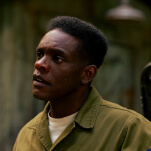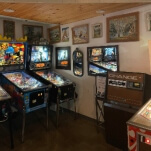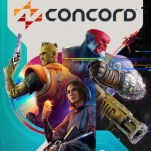More than 56,000 people attended Gen Con in August, a 14 percent increase from 2013’s record-breaking numbers. The four-day annual convention dedicated to games of all types has such a huge impact on the city of Indianapolis that bars screen Spaceballs and Army Of Darkness instead of sports, hotels serve Butterbeer in their lobbies, and pedicab drivers dress up as Super Mario Bros. characters.
The event has also become the place for major developers and indie designers to show off their new work and test their games to gauge interest. There are far too many new games at the convention to play them all, even if you weren’t spending time on the event’s other attractions, which this year included a Dungeons & Dragons-themed party, laser tag, and a hentai screening so popular the line wrapped around one of the Indiana Convention Center’s long halls. But here’s the skinny on the games we tried and when you might be able to play them yourself.
The game can be frustrating. “Leadership” of the group passes with the dice, and leaders are solely responsible for handling road events, so there’s no guarantee that events will fall to a character with an appropriate strength. Random rolls may mean the socially inept fighter-type gets all the talking-and-charming encounters, while the fast-talking social characters keep taking damage from wandering monsters.
The sheer number of complications in the game can be confusing. There’s a short form of combat called Skirmish, where one player takes the lead and another plays the enemy. There are “Power Points” to collect and use to activate special abilities. There’s treasure to amass, which can be used to buy things in town spaces on the board. There are different adventures with different difficulty levels and storylines. (Each adventure is meant to take about three hours to play.) But while there’s a lot going on in Folklore: The Affliction, the storyline and the mix of style ideas feel innovative. Not quite a board game, a role-playing game, or a videogame combination of both, it’s an experience with a lot of flavor and depth.
But there’s always a catch. Sharing skills on the neural net means sharing emotions, fears, and traumas as well. Skills are driven by baggage like pride, rage, grief, and fear, and using those skills can build stress to a point where it feeds back on the entire group, causing irrational behavior.
Essentially, Headspace is like psychic group-therapy Shadowrun, with plenty of bad-ass derring-do complicated by periodic mental breakdowns. Designer Mark Richardson has the nugget of a really interesting idea in this game, which links players in a state of extreme mental and emotional intimacy and gets at the damage under the surface of so many heroic characters.
There are problems with the game in its current form, though—chief among them is that there are no contested moves or difficulty setting for rolls. Hacking mom’s computer to learn her library-card number and wiping out the power grid of an entire city is the exact same roll for the Tech. That could lead to some entertainingly high-powered games, but for the moment, Headspace lacks a sense of exterior-world complexity to match the complexity of its innerspace rules.
Release status: It’s still in play-test mode, so the designer has made the rules available free online, along with play-test scenarios from Origins and Gen Con. Richardson is considering a Kickstarter in 2015, so this is a good time to try it out and offer feedback to improve the game, which currently looks tremendously promising but in need of some retooling. [TR]
Pandemic: Contagion
The gist: Saving the world requires teamwork. Wrecking it doesn’t.
How it’s played: A spin-off of Z-Man Games’ collaborative board game, Pandemic, Pandemic: Contagion is a competitive card game where each player controls one of the four diseases that have vexed so many CDC agents. You’ll find the familiar city cards from the board game, with each one having a maximum number of disease cubes it can be loaded up with before becoming utterly uninhabitable. If you’re the dominant disease in a city when that happens, you get a bunch of points, and plagues with less of a presence get runner-up values.
The game also has scoring phases randomly determined by card draws, so even if you’re nowhere close to eliminating Paris, you can still get some points if you’re the only plague in town. But spreading out has its downside since you have a limited number of plague cubes, and you can only get them back when a city is closed.
Pandemic: Contagion also has a simple evolution mechanic that lets you spend the cards you might otherwise use for plague spreading to make your other actions more effective by letting you draw extra cards or place more cubes each turn. Evolving can also make you less vulnerable to events like a “Hand washing campaign” that can stop your progress.
Release status: The game will be on sale in November. [SN]
Patient Zero
The gist: You’re a disease. Evolve and spread before the CDC stops you.
How it’s played: Patient Zero plays like a significantly more complex version of Pandemic: Contagion, drawing its inspiration from actual biology. Each player gets a card with either a real or made-up infectious disease ranging from cholera to “the shits and giggles.” To build the disease, you need to evolve by acquiring symptoms in various categories such as blood, mind, and tissue. The first options in each category are mild, like nausea or a rash, but as you progress down a path they get progressively more awful until you’re bragging about causing dysentery and encephalitis.
Each turn, players choose whether to evolve or spread. The designers use real-world epidemiology as the guide for their world map, so diseases are more likely to thrive in densely populated, poor, and humid areas but have a harder time getting a foothold elsewhere. That means you have to roll quite high to infect Canada, but it’s easier to ravage India. There are also opportunities to reenact every plague-themed apocalyptic scenario and hop a plane to somewhere entirely different.
Sticking to the card gets you extra points at the end of the game, but if the symptoms you need don’t show up when you’re ready to buy them, you can always build your own plague. (I was supposed to be chlamydia but wound up with a particularly lethal infection the table referred to as “the bloody clap.”) The game has plenty of viable roads to victory, but attacking your opponents isn’t really one of them. The best tactic is to stake out your own corner of the world to utterly ruin.
Release status: BHG is working on a Kickstarter for its ant-themed game King Of The Hill. A Kickstarter for Patient Zero is planned to follow. [SN]
Abyss
The gist: An underwater influence-buying auction game has players vying to become the new Aquaman.
How it’s played: Two to four players attempt to take control of an underwater city by bidding for control of the lords of various undersea factions. Players take turns revealing a series of cards for color-coded factions like Crabs, Octopi, and Jellyfish. If they choose to take a revealed card, their turn ends; if they pass on it, other players can pay them for it, which increases the price of the cards as they continue revealing up to their limit of five. Eventually, players will use faction cards to buy lords, which each have different values and faction-card requirements but come with special abilities like decreasing the price of later buys, increasing prices for everyone else, or multiplying influence. They also provide points toward winning. The game ends when someone accumulates seven lords, but some lords are much more valuable than others, and a few high-point lords with the right multipliers may be better than seven lower-value ones.
This all amounts to a pretty standard-issue auction game, and a play-through is only meant to last around 45 minutes. The big appeal is the gorgeous painted art, all deeply saturated underwater blues and purples, flecked with bioluminescent jewel tones. There’s more depth to some facets of the game as well. Faction cards no one chooses during the reveal phase go to a limbo called The Council, where players can pick them up in lieu of a turn. For card-counters who’ve kept track of the value of rejected cards, this can be a considerable payday. And some lords come with key symbols; accumulate too many key symbols, and they unlock a location, which gives the player an influence bonus, but cripples the key-bearing lords by shutting down their special powers. Those two twists can make for game-winning strategies, but otherwise, the game feels somewhat mechanical and standard.
Release status: Released at Gen Con, available in game stores. The publisher, Asmodee—the company behind hits like 7 Wonders, Dixit, Timeline, and more—doesn’t have an online store but does list retailers that carry its games. [TR]
Munchkin Panic
The gist: Castle Panic and Munchkin had a cute little love child.
How it’s played: Oh no, Munchkin monsters are emerging from the forest all around you to attack your flimsy cardboard castle! That Maul Rat may be an easy target, but the Leperchaun and the Pukachu both look pretty gross, and there’s a deadly Gazebo lurking just behind them. And the Wight Brothers are sneaking up from another sector entirely. Panic!
Or just talk your fellow players into helping you. Like Castle Panic, Munchkin Panic is a mostly collaborative tower-defense game, where one to six players try to kill a swarm of incoming beasties moving through a series of concentric, color-coded circles to attack a castle at the center of the board. Players fight off the monsters with cards that match the monsters’ sectors in color and position. Like Munchkin, the game lets players ask other players for help in exchange for treasures or trophies. Killing that valuable, high-powered monster may take a lot of cooperation, which diffuses the rewards considerably, but if players hoard their cards, the castle may get flattened, at which point everyone loses. Players only get to compare points and see who won if they survive until the wave of attackers finally dries up. It’s a quick and simple family game, with players taking turns using cards to kill monsters, and new monsters appearing on the board each round.
Castle Panic and Munchkin are both popular, and the combination feels natural: The familiar Munchkin puns and John Kovalic’s instantly recognizable Munchkin art gives the game a more cartoonish, playful, kid-friendly feel, while the Munchkin selfless-in-cooperation dynamic makes things just a little tenser for adult players.
Release status: No official release date has been set, but a rep at Gen Con said it’s currently expected to be ready for shipping in mid-October. The release company, Fireside Games, has it available for pre-order. [TR]
The Strange
The gist: A tabletop RPG as big as the world’s collective imagination.
How it’s played: The latest role-playing game from Numenera lead designer Monte Cook uses Numenera’s stripped-down rule system: Player characters only have a one-sentence description that sums them up, plus a few basic stats and skills. There are only three character classes: Vectors (who use action or force to solve problems), Paradoxes (who use magic, mad science, or other reality-breaking tools), and Spinners (who use storytelling and social skills). But this time, the setting focuses on The Strange, a gigantic artifact that makes fictional worlds into real places called “recursions.” The Strange comes with its own original recursions, but game masters can also build recursions from any they’ve read or heard or thought about, from Amber to Discworld to all the master’s previous RPG settings. And people and objects can cross between worlds, which can be a lot of fun for the players or a lot of stress for Earth governments when, say, a South American guerilla army turns up with lightsabers or weirding modules.
A sample game at Gen Con cast players as operatives of The Estate, a S.H.I.E.L.D./Men In Black-style organization policing the movement of individuals and objects between worlds. It’s more a storytelling game than a crunchy systems-based one, but the simplicity of the rules makes it a snap to pick up and understand completely in a short session. The setting could be daunting, because literally any story could be told in this environment, but that’s also what makes it such an exciting new game.
Release status: Its hugely successful Kickstarter concluded in August 2013. The game was released at Gen Con and is available in book or PDF form via Monte Cook Games, DriveThruRPG, and other online game retailers. [TR]
Ortus Regni
The gist: Warring earls vie for control of late Anglo-Saxon England.
How it’s played: Players fight on a variety of fronts, fielding armies and assassinating rival leaders through intrigue and even sending diplomats to deal with the Vikings in order to get their hordes to assault your enemies instead of your own castles. You have to divide your resources between building lands—since you lose the game if your entire fief is destroyed—and deploying forces that can protect them.
Much like actual medieval nobility, players also have to look to the future. When your deck runs out of cards, your earl dies and his empire crumbles unless he’s named an heir, in which case you can reshuffle the deck. Doing this is also tricky and subject to interference from players whose decks are focused on the power of the church. There are also sub-games, like jousts, that allow you to settle conflict with nonlethal combat. Luckily while you’re agonizing about what move to make you’ve got some beautiful cards to look at, with images based on medieval art.
Release status: The production version of the game can be purchased directly from Jon Sudbury Games, and a free print-and-play version is available at ortusregni.com. [SN]
Dream Heist: The Game Of Your Dreams
The gist: Inception in board game form.
How it’s played: The first game from Detroit-based startup Pilot Study feels like a familiar dream: It’s so openly modeled after Christopher Nolan’s film Inception that one of the player tokens is the metal top Leonardo DiCaprio uses in the film. In a particularly nifty touch, each player gets a personalized totem—a poker chip, say, or a gold ring—but players are encouraged to use their own small personal objects as tokens, just like the characters in the film. Also like Inception’s cast, Dream Heist players descend through different levels of consciousness in a dreaming mind, planting ideas in the mark’s subconscious. Two to five players each get a separate mission, like “Steal Competitor’s Aircraft” or “Sabotage An Actress.” The mission specificities don’t actually matter, but they’re clever and add flavor, with breakdowns of how each member of a player’s team separately contributes to the heist.
Players roll dice and race around the board, landing on symbols that determine whether they get a crew card or a special action card. They can also complete a mission by turning in cards and placing pieces on the board. Those pieces represent accomplished tasks, but they also block other players from dabbling in the same areas, which limits late-game choices considerably. The game’s big problem is that it’s heavily reliant on dice luck, but there are plenty of strategy choices as well, especially in choosing which dream level to operate on and blocking out other players. It also moves briskly, especially once one player completes all mission parameters, and everyone has to race back to the top level of the mark’s mind, or risk getting stuck in limbo.
This feels more like a family-night game than Inception felt like a family-night movie—at least it won’t leave anyone arguing about whether the little metal top token wobbled at the end of the game.
Release status: The Kickstarter funded at 200 percent of the initial goal back in April, and the game release was planned for August 2014. At Gen Con, the game and art designers said they were still finalizing some cards, and should be ready to ship orders within four to six weeks of Gen Con. It’s available for pre-order at the company’s website. [TR]
Section 17
The gist: Save the world from aliens… on a tight deadline.
How it’s played: A single alien mothership has devastated Earth, and it took the combined force of the entire planet to bring it down. Cobbling together tech from the wreckage, Earth’s government has determined that a whole fleet is on the way, and the world has one year to prepare for its arrival. Up to five players take on the roles of major governments and choose research, recruitment, or equipping each month, upgrading their defenses both against the eventual attack and in the short-term against stray landings around the world. When a random attack on a city is determined, players better hope they’ve allocated enough points into research to be able to detect the sector where it lands. If so, soldiers rush to the site, and a hand-to-hand battle breaks out.
Section 17 is a resource-management game on a macro and micro level. In the big picture, governments collaborate on developing technology or selfishly grab the limited resources that will keep their own soldiers alive. On the micro level, each month can feature a grid-based fight between soldiers with different powers and weaponry against randomly drawn aliens with different move patterns and abilities. It may take several soldiers to bring an alien down, but only the one that scores the kill shot gets the experience points needed to upgrade to cooler powers. But since it takes a precious one-month slot to train a new soldier, caution and cooperation are necessary: Players who try to Rambo every alien in sight will probably get their soldiers killed and wind up back at square one on upgrades, with a terrifying fleet of invaders breathing down their necks.
Gen Con marked Section 17’s first public outing, and it doesn’t have art or yet, but it already seems like a fairly polished game in terms of complexity and playability. It necessitates some exhilaratingly hard choices—there’s no way to nab all the possible upgrades before the invasion fleet arrives, so it’s important to prioritize and share the glory. The combat grid has some of the complexity of a miniatures game but with simple, easily understood rules for movement and blocking. The “upgrade for a year, then fight” structure adds tension and keeps the game from sprawling. This one’s a lot of fun, even if Earth does end up dying with a whimper rather than a bang.
Release status: Here’s a strange and unusual move: According to Section 17’s play-test leader, Null Sector Games designer Ryan Brady isn’t planning a Kickstarter for the game, “because he already has a full-time job he likes.” He’s just looking for a publisher. As enjoyable as the game is, though, it may be hard to make connections with virtually no information available on the web, apart from a bare-bones Facebook page and Twitter account. Hopefully that full-time job won’t keep this game from seeing the light of day. [TR]
Golem Arcana
The gist: Field an army of monsters using miniatures and digital content.
How it’s played: Golem Arcana takes the tape measurers and rulebooks out of miniatures games. Players tap figures’ bases with a stylus, which makes their relevant stats pop up on a smartphone or tablet equipped with the game’s app. You can learn the monster’s abilities and see where it can move, then tap the enemy you’re targeting to display how likely you are to hit and what kind of damage you’d do.
All of the detail on how those numbers are derived are available to curious players with a few extra clicks and if you want the tactile feel of rolling dice instead of letting the app handle randomization, you can do that and just manually enter your numbers.
This was the most ambitious game we saw at the show because the digital component holds so much potential for easy expansion. The titular golems are ridden by knights with their own special abilities, which can be introduced and swapped out electronically. You can engage in simple head-to-head skirmishes or play using scenarios that might provide unpredictable advantages or disadvantages for going to certain areas of the map, including quests that tie into the game world’s plot. The global narrative will be affected by the decisions players make and playing more can earn you in-game rewards.
The developers have a roadmap for features they want to release over the next year. They’re considering adding AI that could make a game collaborative instead of competitive and plan to introduce remote play allowing players to compete from across the country both at home and at gaming store events.
Release status: The game is available to purchase online. [SN]






































